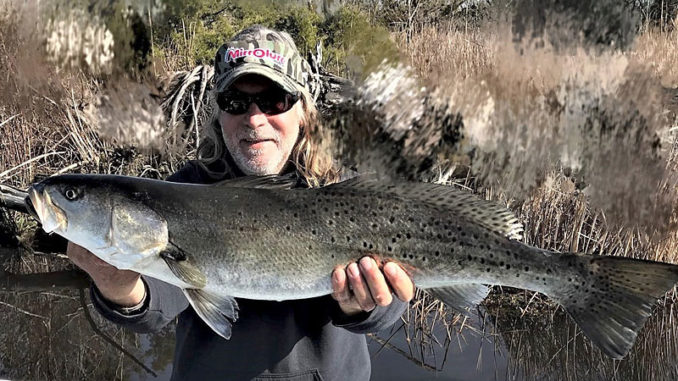
New River seatrout are warming up
Fishing in inshore waters begins to awaken along the New River and North Carolina’s central coast this month, especially for spotted seatrout.
No one knows that better — or is in a better location — than guide Ricky Kellum of Jacksonville. He knows when and where the bite heats up for early spring specks in the New River.
“(March) is the month when you can catch specks way up the river’s creeks,” said Kellum, who runs The Speckled Specialist Guide Service. “In March, we catch bigger trout in the creeks. They can weigh up to 4 or 5 pounds. And it’s not unusual to get a 6-pounder.
“French’s, Wallace, Duck, Northeast, Southwest, Mill and Stones creeks all can be good,” said Kellum (910-330-2745). He uses artificial and live bait to target trout, depending upon the skill level of his clients.
Water temperature isn’t a crucial factor, he said. But if it’s 50 degrees or higher, specks generally will actually chase lures and live baits.
“It’s crazy how trout can be so active when it’s cold,” said Kellum, who often catches his biggest specks in January and February. “The river and creeks have a lot of natural springs. That water helps keep water temperatures higher than expected.
“The biologists say if the temperature gets above 50, we can catch ’em with topwater lures. Sunny days that warm up mud bottoms also get trout going.”
Go bright on lure color choices
His go-to surface lures include Zara Spooks, Spook Jrs. and Top Dogs with chartreuse heads and pink or white bodies.
“I also throw a chartreuse shrimp,” Kellum said. “I use bright colors when the river has dark water.”
Kellum’s favorite sinking lures include a 1/4-ounce Billy Bay Halo Shad, Betts Halo Shrimp or Perfect Sinker Shrimp.
“A (MirrOlure) MR 17 can be really good in March, too,” he said.
If his clients aren’t skilled in fishing artificial lures, Kellum uses live mullets or mud minnows on slip-cork rigs.
“I fish them a foot or so off the bottom,” he said.
With the completion of the New River Oyster Highway last spring, local anglers enter their third season of fishing oyster reefs stretching more than 30 miles from Wilson Bay to Stones Bay near Camp LeJeune.
“It’s added greatly to the river’s fishing,” said Kellum, whose clients discovered a trout pattern by casting off the reef 20 yards on one trip “just for something to do” while waiting for the red drum bite to begin.
Kellum’s tackle includes 7-foot, medium-action, fast-taper Cashion Rods mated to 2500 series Stradic spinning reels spooled with 10-pound Sufix braid and a 20-pound fluorocarbon leader, depending on water clarity.





Be the first to comment